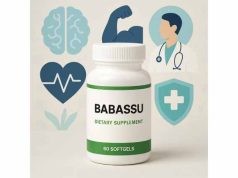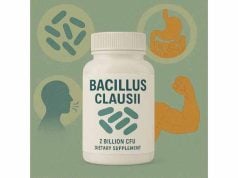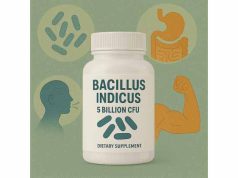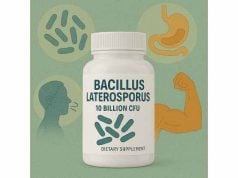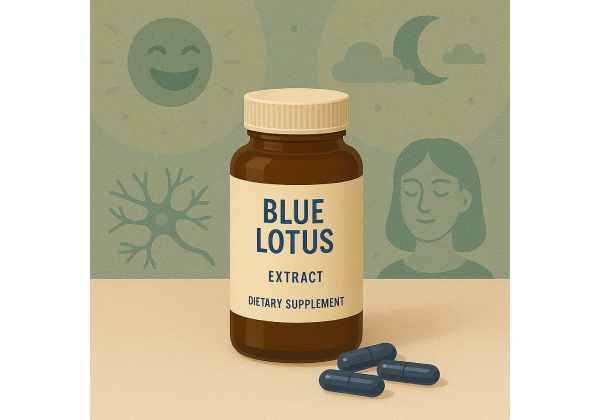
Blue Lotus extract, also known as Nymphaea caerulea, is gaining widespread attention as a natural supplement for relaxation, mood enhancement, and mental clarity. Historically revered in ancient Egyptian and Eastern wellness traditions, Blue Lotus is prized for its subtle calming effects, gentle euphoria, and unique phytochemical profile. Today, it’s used in teas, tinctures, and topical applications for stress reduction, improved sleep, and heightened sensuality. This guide explores what makes Blue Lotus so special, how it works in the body, its key benefits, recommended dosage, and important safety considerations, helping you make informed decisions about its use in your wellness routine.
Key Takeaways
- Blue Lotus extract is best known for its relaxing, mildly euphoric effects and calming impact on the mind and body.
- The active compounds, including aporphine and nuciferine, support mood balance and may enhance sleep quality.
- Traditionally used for meditation, stress relief, and sensuality, Blue Lotus remains popular in holistic and herbal wellness circles.
- Most users experience gentle benefits, but proper dosing and safety awareness are essential to avoid side effects.
- Blue Lotus is available in teas, tinctures, resins, and aromatherapy products, offering flexible options for different preferences.
Table of Contents
- Blue Lotus Extract Overview: What It Is and How It Works
- Mechanisms of Action: How Blue Lotus Affects the Mind and Body
- Science-Backed Benefits and Practical Uses of Blue Lotus Extract
- Safety Profile, Side Effects, and Interactions of Blue Lotus
- Optimal Blue Lotus Dosage, Forms, Usage, and Timing
- Blue Lotus Extract FAQs: Top Questions Answered
Blue Lotus Extract Overview: What It Is and How It Works
Blue Lotus extract is derived from the blue lotus flower, known botanically as Nymphaea caerulea. This aquatic plant has long been associated with sacred rituals, spiritual practices, and holistic wellness in ancient Egypt and parts of Asia. Blue Lotus was revered as a symbol of creation and rebirth, often depicted in temple art and used in ceremonial wine to enhance relaxation and promote spiritual insight.
The extract is typically made by soaking the petals, stems, or whole flowers in alcohol or water to concentrate its active ingredients. Blue Lotus is available today in several forms, including dried flowers, powders, tinctures, essential oils, and resins. Each preparation offers unique ways to enjoy the plant’s subtle yet distinct effects.
What sets Blue Lotus apart from other herbal supplements is its unique combination of phytochemicals. Chief among these are aporphine and nuciferine—alkaloids thought to contribute to its relaxing, mildly psychoactive properties. Unlike many modern relaxation supplements that can cause drowsiness or cognitive dulling, Blue Lotus is often described as gently uplifting, with users reporting a sense of calm clarity and enhanced sensory awareness. This makes it popular among those seeking relaxation without sedation, creative inspiration, or a meditative mindset.
Beyond its calming effects, Blue Lotus extract is also used for its sensual and aphrodisiac qualities. In both historical and modern contexts, it’s considered a botanical for enhancing intimacy, heightening tactile sensations, and deepening emotional connection. Many users find that a cup of Blue Lotus tea or a small dose of tincture before bed helps promote restful sleep and encourages vivid, meaningful dreams.
Today, Blue Lotus is regaining popularity not only for its traditional uses but also as part of the broader movement toward natural wellness, holistic self-care, and plant-based mood support. With its appealing combination of history, science, and subjective benefits, Blue Lotus is being embraced by people seeking natural ways to unwind, restore balance, and nurture mental well-being.
When considering Blue Lotus extract, it’s important to recognize that its effects can vary depending on preparation, dosage, and individual sensitivity. While some users experience gentle euphoria and deep relaxation, others may notice only mild benefits. This wide range of responses makes it essential to start with a low dose and adjust gradually as needed.
Whether you are curious about its cultural legacy, interested in exploring herbal relaxation aids, or seeking alternatives for mood support, understanding what Blue Lotus extract is—and what it isn’t—will help you decide if it’s right for you.
Mechanisms of Action: How Blue Lotus Affects the Mind and Body
Blue Lotus extract exerts its effects through a fascinating interplay of natural compounds that act on the brain and nervous system. While scientific studies on Blue Lotus are still emerging, its two most well-documented alkaloids—aporphine and nuciferine—are thought to be primarily responsible for its unique psychoactive and physiological effects.
Aporphine is a naturally occurring compound in the blue lotus flower. Structurally, it’s related to dopamine—a neurotransmitter central to mood, pleasure, motivation, and alertness. Aporphine interacts with dopamine receptors in the brain, potentially leading to feelings of gentle euphoria, elevated mood, and an overall sense of well-being. Unlike stronger psychoactive substances, aporphine produces subtle changes that most users describe as mellow, calm, and introspective.
Nuciferine, the second major alkaloid, is known for its potential to promote relaxation and reduce restlessness. This compound acts as a mild antipsychotic and is thought to modulate serotonin and dopamine pathways—key chemicals that influence mood, anxiety, and sleep patterns. Nuciferine’s ability to gently balance neurotransmitters may explain why Blue Lotus is often used for calming the mind and easing stress without causing strong sedation or dependency.
When consumed—whether as a tea, tincture, or inhaled aroma—the active compounds in Blue Lotus rapidly cross the blood-brain barrier, allowing them to exert effects within minutes to an hour. Many users report a warm, soothing sensation and a reduction in mental chatter, making the extract ideal for meditation, creative pursuits, or winding down before sleep.
Beyond the brain, Blue Lotus may have other effects on the body. Some users notice mild muscle relaxation, a decrease in physical tension, and a general sense of physical comfort. This somatic relaxation may be due to the plant’s gentle influence on the parasympathetic nervous system—the branch of the nervous system responsible for “rest and digest” functions.
In addition to its alkaloid content, Blue Lotus also contains antioxidants and flavonoids—plant-based compounds that help protect cells from oxidative stress. While the antioxidant properties of Blue Lotus are not as extensively studied as those of green tea or turmeric, preliminary research suggests that regular use may support overall cellular health and resilience to stress.
Another unique property of Blue Lotus is its reputed role as a natural aphrodisiac. Historical texts and modern user reports alike describe heightened tactile sensitivity, increased intimacy, and improved sensual connection. These effects may result from the plant’s relaxing influence on the mind and body, which can reduce performance anxiety and foster a deeper sense of emotional presence.
It’s important to note that Blue Lotus does not act as a sedative or hallucinogen in the same way as stronger substances. Its psychoactive effects are best described as gentle, with a focus on clarity, relaxation, and enhanced mood rather than dramatic changes in perception or consciousness. Most users can enjoy its benefits while remaining fully aware and functional.
The mechanisms behind Blue Lotus’s effects are still being explored, and more scientific studies are needed to clarify its actions in humans. Nevertheless, centuries of traditional use, combined with modern anecdotal evidence, provide a compelling case for its role as a natural tool for relaxation, mood support, and mind-body balance.
For those considering Blue Lotus extract, understanding how it interacts with the body’s biochemistry is the first step toward safe and effective use. As with any supplement, individual response can vary, so starting with a small dose and observing your own reactions is the best approach.
Science-Backed Benefits and Practical Uses of Blue Lotus Extract
Blue Lotus extract’s allure goes far beyond its ancient mystique. In recent years, modern wellness seekers and researchers alike have begun to explore its broad spectrum of practical uses, from calming stress to supporting sleep and enhancing mood. While large-scale clinical studies remain limited, the combined weight of traditional wisdom, small human trials, and abundant user reports highlights several science-backed benefits and creative applications.
1. Natural Stress Reduction and Mental Relaxation
One of the most popular uses of Blue Lotus extract is for stress relief. Its calming properties are attributed to the unique alkaloid blend—particularly aporphine and nuciferine—which help balance neurotransmitters like dopamine and serotonin. Many users report that a cup of Blue Lotus tea or a dropper of tincture quickly eases feelings of overwhelm, tension, and nervousness, making it a preferred choice for winding down after a busy day or navigating challenging situations with greater composure.
2. Enhanced Mood and Mild Euphoria
Blue Lotus is widely praised for its mood-lifting effects. Unlike more stimulating herbal supplements, its effects are characterized by gentle euphoria and a pleasant sense of contentment rather than intense excitement or jitteriness. Users often describe feeling more optimistic, at peace, and in tune with themselves, which makes Blue Lotus a supportive tool for those experiencing occasional sadness or mood fluctuations.
3. Improved Sleep Quality and Restful Nights
Another standout benefit is its ability to support healthy sleep patterns. Blue Lotus extract, especially when used in tea or tincture form before bed, helps many people fall asleep more easily, stay asleep longer, and wake feeling refreshed. This may be due to its gentle modulation of serotonin and dopamine, neurotransmitters involved in the sleep-wake cycle, as well as its calming influence on the body’s stress response.
4. Meditative Focus and Creative Inspiration
Because Blue Lotus promotes a state of calm clarity rather than heavy sedation, it is a favorite among meditation practitioners, artists, and writers. Many report that it quiets mental distractions while enhancing introspection, creativity, and the ability to enter “flow” states—periods of heightened focus and effortless productivity. Blue Lotus may serve as a gentle bridge to deeper meditation, creative brainstorming, or mindfulness exercises.
5. Sensual Enhancement and Relationship Intimacy
Unique among herbal extracts, Blue Lotus is celebrated for its sensual and aphrodisiac effects. It has a long history of use in rituals aimed at deepening emotional and physical connection. When used mindfully, it may help reduce anxiety or tension around intimacy, boost sensitivity to touch, and create a sense of emotional openness. These qualities make it appealing for couples and individuals seeking to enrich their relationships or simply explore new dimensions of pleasure.
6. Support for Emotional Balance and Occasional Anxiety
Blue Lotus’s soothing properties extend to emotional well-being. For those who struggle with occasional anxiety or emotional turbulence, its extract may help smooth mood swings and foster greater emotional resilience. Users often describe feeling more grounded, less reactive to stressors, and better equipped to navigate life’s ups and downs with calm perspective.
Practical Ways to Use Blue Lotus Extract
- Tea: Steep dried petals or prepared tea bags in hot water for 5–10 minutes.
- Tincture: Place drops under the tongue or add to water or juice for faster absorption.
- Resin: Dissolve a small piece in warm liquid or use as incense for aromatherapy.
- Topical: Infuse Blue Lotus oil into bathwater or use in massage blends for localized relaxation.
Who Can Benefit?
Blue Lotus extract may be particularly useful for adults seeking gentle support for stress, sleep, mood, or emotional balance. It is also valued by those who want to deepen meditation, foster creativity, or enhance sensual experiences naturally. However, it is not intended for children, pregnant or breastfeeding women, or those with specific medical conditions unless guided by a healthcare provider.
Limitations and What to Expect
While Blue Lotus offers many appealing benefits, it is not a cure-all and may not work for everyone. Its effects are generally subtle, cumulative with consistent use, and best paired with other healthy lifestyle habits. Results depend on the form used, the dose, individual biochemistry, and the overall context of use.
Ultimately, Blue Lotus extract stands out as a multifaceted herbal supplement with roots in both ancient tradition and modern wellness. Whether you seek a calming nightcap, a mood boost, or a ritual for relaxation, Blue Lotus invites you to rediscover natural balance and serenity.
Safety Profile, Side Effects, and Interactions of Blue Lotus
Understanding the safety profile and potential side effects of Blue Lotus extract is crucial for responsible, informed use—especially as interest in this supplement grows among natural wellness enthusiasts. While Blue Lotus is generally considered gentle and non-habit forming, its unique alkaloids can produce effects that vary by individual, dose, and product quality.
1. Safety Overview and General Tolerability
Blue Lotus has a long history of traditional use, typically without reports of serious harm when used in moderate amounts. Most healthy adults tolerate it well, experiencing only mild, short-lived effects such as gentle relaxation, mood elevation, or drowsiness. There is no evidence of physical addiction or dependence with typical use, and withdrawal symptoms are not reported.
However, as with any supplement that acts on the central nervous system, Blue Lotus is not risk-free. Its effects can be amplified or altered by individual biology, other supplements, or certain medications. People with a history of sensitivity to psychoactive substances, or those prone to adverse reactions from herbal products, should exercise extra caution.
2. Known and Potential Side Effects
Reported side effects from Blue Lotus are rare but may include:
- Drowsiness or sedation: Especially at higher doses, some users may feel sleepy or less alert. It is advisable not to drive or operate heavy machinery after taking Blue Lotus, until you understand your own response.
- Dizziness or lightheadedness: Mild changes in blood pressure or circulation can occasionally lead to a sense of lightheadedness or vertigo, particularly in sensitive individuals.
- Digestive upset: Nausea, stomach cramps, or mild gastrointestinal discomfort are possible, especially if taken on an empty stomach or in excessive amounts.
- Mild confusion or fogginess: In rare cases, especially at higher doses, users may feel a temporary “brain fog” or slight confusion that resolves as the extract’s effects wear off.
- Allergic reactions: Though uncommon, allergic responses such as skin irritation, rash, or swelling are possible, particularly with topical use or impure products.
3. Blue Lotus Extract Interactions with Medications and Other Supplements
Blue Lotus’s alkaloids interact with neurotransmitter systems (dopamine, serotonin), which means it can potentially interact with certain medications and supplements. Specifically:
- Antidepressants (SSRIs, MAOIs, tricyclics): Because Blue Lotus can mildly influence serotonin and dopamine, combining it with prescription antidepressants may increase the risk of serotonin syndrome—a rare but serious condition. Always consult a healthcare provider before combining these.
- Sedatives, benzodiazepines, sleep aids, or alcohol: Blue Lotus may enhance the sedative effects of these substances, leading to increased drowsiness, reduced coordination, or impaired judgment.
- Antipsychotics or mood stabilizers: Interactions are possible, particularly due to the presence of aporphine and nuciferine, which modulate neurotransmitters affected by these drugs.
- Blood pressure medications: Blue Lotus may have a slight relaxing effect on blood vessels, which can interact with antihypertensive drugs, potentially lowering blood pressure further.
When in doubt, always check with a physician or pharmacist, especially if you are taking medications for mental health, sleep, heart conditions, or chronic illnesses.
4. Precautions and Who Should Avoid Blue Lotus
While Blue Lotus is safe for most adults when used occasionally and responsibly, some groups should avoid or use it only under medical supervision:
- Pregnant and breastfeeding women: There is insufficient safety data on Blue Lotus use in pregnancy or lactation. It is best to avoid unless specifically approved by a healthcare provider.
- Children and adolescents: Due to its psychoactive potential and lack of safety research in younger people, Blue Lotus is not recommended for minors.
- Individuals with psychiatric disorders: Those with schizophrenia, bipolar disorder, or other severe psychiatric conditions should avoid Blue Lotus, as its dopamine and serotonin activity could exacerbate symptoms or interact with psychiatric medications.
- People with a history of substance abuse: Although non-addictive, Blue Lotus’s mood-altering effects may not be appropriate for those with a history of substance misuse.
5. Product Quality and Legal Status
Not all Blue Lotus products are created equal. Choose reputable suppliers who provide purity testing, clear labeling, and transparent sourcing. Some products may be contaminated, adulterated, or misidentified, which can increase risk.
Legally, Blue Lotus’s status varies worldwide. In most countries and U.S. states, it is legal to possess and use as a supplement or incense, but a few regions restrict its use or sale. Always check your local laws before purchasing or importing Blue Lotus products.
6. Responsible Use and Harm Reduction
- Start with the lowest effective dose, especially if you are new to Blue Lotus.
- Avoid combining Blue Lotus with other psychoactive substances, alcohol, or sedating medications.
- Do not drive or perform safety-sensitive tasks until you know how it affects you.
- If you experience persistent or severe side effects, discontinue use and consult a healthcare provider.
Blue Lotus extract is generally safe for healthy adults, but it’s important to use it mindfully and respect its effects on the mind and body. Informed, responsible use maximizes benefits and minimizes risks.
Optimal Blue Lotus Dosage, Forms, Usage, and Timing
Finding the right dosage and best way to use Blue Lotus extract is key to experiencing its subtle benefits while avoiding unwanted effects. Because Blue Lotus is used both for relaxation and for enhancing specific experiences like meditation, creative work, or intimacy, your ideal approach may vary depending on your goals and personal response.
1. Common Forms of Blue Lotus Extract
- Dried Flowers: The most traditional form, often steeped to make tea or infused into wine or oil.
- Tincture: A concentrated liquid extract, typically taken sublingually (under the tongue) for fast absorption.
- Resin: A sticky, concentrated solid that can be dissolved in warm water, used in aromatherapy, or smoked (where legal).
- Capsules and Tablets: Convenient and consistent, these offer precise dosing, but effects may onset more slowly.
- Essential Oil: Primarily used for aromatherapy and topical applications, not intended for oral ingestion.
Each form varies in potency, onset time, and duration of effects. Always read product labels and follow manufacturer instructions.
2. General Dosage Guidelines
There are no universal dosage standards for Blue Lotus extract, since potency can vary between products and individual sensitivity plays a large role. However, these guidelines provide a starting point:
- Tea (dried flowers): 3–5 grams steeped in hot water for 5–10 minutes, up to twice daily.
- Tincture: 5–10 drops under the tongue or mixed in water, up to three times daily. Start lower and increase as needed.
- Resin: 0.1–0.3 grams dissolved or used as incense, once daily or as desired.
- Capsules/Tablets: 250–600 mg per serving, not exceeding recommended label dose.
Begin with the smallest effective dose to gauge your response. Some people are more sensitive and will benefit from much less.
3. When and How to Take Blue Lotus
- For Relaxation: Use in the evening or before bedtime to unwind, enhance sleep, or promote vivid dreaming.
- For Meditation or Creativity: Take 30–60 minutes before meditation, journaling, or creative work to encourage a calm, introspective state.
- For Social or Sensual Occasions: Dose sparingly and mindfully before events or intimate moments to heighten connection and reduce anxiety.
- With Food or Drink: Blue Lotus tea and tinctures can be taken on an empty stomach or after a light meal; some find it gentler when not fasting.
Effects usually begin within 15–60 minutes, depending on form and individual metabolism, and may last 2–4 hours.
4. Tips for Safe and Effective Use
- Hydrate: Drink plenty of water, especially when using resin or more concentrated extracts.
- Avoid Mixing: Do not combine with alcohol, prescription sedatives, or other psychoactive supplements.
- Cycle Use: Consider taking breaks (e.g., use a few days per week, not daily) to prevent tolerance and preserve sensitivity.
- Keep Notes: Track your doses, timing, and effects to identify your optimal regimen.
5. What to Expect and Adjustments
Blue Lotus’s effects are gentle and often cumulative. Some users notice immediate relaxation, while others require several uses to feel the full benefits. If you don’t notice effects at a low dose, gradually increase in small increments—but do not exceed recommended amounts. Too much may lead to excessive drowsiness or mild discomfort.
If you are new to herbal supplements or have underlying health conditions, consult a healthcare provider before adding Blue Lotus to your routine. Personalization, patience, and mindfulness are key to enjoying Blue Lotus safely and effectively.
Blue Lotus Extract FAQs: Top Questions Answered
How does Blue Lotus extract make you feel?
Blue Lotus extract typically creates a mild sense of relaxation, calm, and gentle euphoria. Most users describe feeling more at ease, slightly uplifted, and introspective, without strong sedation or altered perception. Effects are subtle and best for stress relief, sleep, or meditation.
Is Blue Lotus extract legal to buy and use?
In most countries and U.S. states, Blue Lotus extract is legal to buy, possess, and use as a supplement, tea, or incense. However, some regions may restrict its sale or import. Always check your local laws before purchasing Blue Lotus products.
Can Blue Lotus extract help with anxiety or sleep?
Many people use Blue Lotus extract to ease mild anxiety and improve sleep quality. Its relaxing properties help calm the mind and body, making it easier to unwind at night. However, effects vary, and it should not replace prescribed treatments for serious anxiety or insomnia.
What is the safest way to take Blue Lotus extract?
The safest way is to start with a low dose of a reputable product, such as Blue Lotus tea or tincture. Avoid combining with alcohol, sedatives, or other psychoactive substances. Monitor your response, and increase slowly if needed, never exceeding label recommendations.
Does Blue Lotus extract cause any side effects or drug interactions?
Blue Lotus is generally well-tolerated, but possible side effects include drowsiness, dizziness, or mild digestive upset. It may interact with antidepressants, sedatives, or blood pressure medications. If you take prescription drugs, consult your healthcare provider before use.
How much Blue Lotus extract should I take for the best results?
Typical starting doses are 3–5 grams of dried flower for tea, 5–10 drops of tincture, or 0.1–0.3 grams of resin. Effects vary by person and product. Start low, increase gradually if needed, and never exceed recommended amounts to avoid unwanted side effects.
Is Blue Lotus extract safe for daily use?
While many users enjoy Blue Lotus occasionally or a few times per week, daily use is not recommended long-term, as tolerance may develop and safety data is limited. Regular breaks can help preserve its benefits and reduce the risk of side effects.
Disclaimer:
The information in this article is provided for educational and informational purposes only. It should not be considered medical advice, nor is it intended to replace consultation with a qualified healthcare provider. Always seek professional medical guidance before starting any new supplement, especially if you have health conditions or take prescription medications.
Enjoyed this guide?
If you found this article helpful, please consider sharing it with friends and family on Facebook, X (formerly Twitter), or any social media platform you love. Your support helps us continue creating quality, science-based wellness content for everyone. Thank you for reading—and don’t forget to follow us for more updates!


